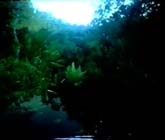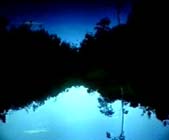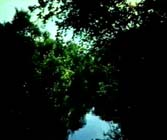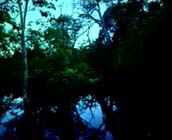|
The artist Ulrike Rosenbach realized with AMA-ZONAS a video and photo installation that was developed as a ritual to ?Farewell to 13 Trees? (caption to the work AMA-ZONAS). Rosenbach photographs trees along the banks of the Amazons in Brazil; she placed the framed photos close to one another on the wall.
Like remnants from another world, the photos report about the zones of our earth which the artist codes as zones of the soul through the use of the title AMA-ZONAS (AMA means soul in Sanskrit).
The video shows the individual images in a 30-minute sequence whereby each image is slowly cross-faded into the next. In so doing, a series of new images is created between the individual photos. Not the formal element of cross-fading because this would be too slow for it and not the individual photos of the trees on the bank are the main focal point, but rather the movement created that corresponds to the similar process of growth and allows new forms of mystical Amazon beauty to be created.
The slow tempo and detailed precision that are emphasized here in the series of images as in other works of Rosenbach, methods that do not correspond to what the television audience is accustomed to seeing ? and that is namely the request to take your ?time.? Upon the soundtrack of the video, there is the rhythmical alternation of silence and a sudden creaking sound. A creaking sound that is created if a tree loses its equilibrium and falls. These elements of the video work that structure time are humorless sounds - and the silence between them. It permits a hopeful pause, exactly enough time to take a breath and thus for the presentation of the idea that there are possibly other options of how this will proceed.
In the repetition, it becomes clear: Destruction and growth do not lie far apart. ?I don?t make videos that are documentation ? but rather documents of the spiritual life? (Rosenbach quote in an interview with Elisabeth Jappe, from: Performance, Ritual, Process; Prestel Publishing House, Munich 1993)
Indeed: The rain forest of the planet Earth is in jeopardy. Still almost 20 years after Rosenberg?s work, the creaking sound of the falling trees is the reality. At present, every 2 seconds, portions of the rain forest disappear that are the size of a soccer field. The rain forest, a highly organized biotope with numerous species, of which approx. 2% are deemed to have been studied in detail, are generally termed as the lungs of the earth. Rosenbach?s designation as the "zones of the soul" refers to the metaphysical significance of these lungs.
We could cynically say that the work is the anticipation of a memorial. However, Rosenbach speculates more about the mystical power of media and rituals. Her "Farewell to 13 Trees" has nothing to do with the gesture of enlightenment; the artist certainly produces a work of grief (Farewell), that is to say that, in this case, it deals with an actual loss. Nevertheless, in her depictions, nature is present as a healing anti-myth. The artist places the monitor in the middle of a rectangular field of salt. The edges of the Amazon banks are reflected in the mirrors that are likewise located in the salt field. In the various mythologies, salt primarily has the meaning of fertility, in the Celtic mythology, the souls come like salt from the water.
For Rosenbach, the use of symbolic characters and materials is primarily a timeless form of communication. Circle, pentagram, salt and fire, which are used in her works, are also carriers of cultural values and judgments, particularly those that are female-specific. With her works, the artist creates ritualistic places where she develops spiritual forms of communication by means of media and performance. "It is a matter of man being in nature and one with nature." (Rosenbach regarding her work Nature Circle Actions, 1970; in: Performance, Ritual, Process; Prestel Publishing House, Munich 1993)
(Suess / translation: www.dieuebersetzer.de) |










